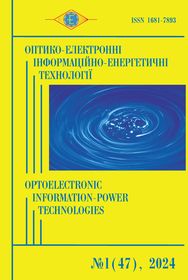Analysis of technology and tools for developing augmented reality systems
DOI:
https://doi.org/10.31649/1681-7893-2024-47-1-66-77Keywords:
augmented reality, immersive technologies, marker-based augmented reality, markerless augmented reality, AR framework, AR platformAbstract
The article presents an analysis of modern technologies and tools for implementing augmented reality (AR) systems. The specifics of the functioning of markerless and marker-based technologies for creating virtual objects are presented, as well as their features and examples of application. The basic components of augmented reality systems are identified and the process of their interaction is detailed. A functional analysis of the most popular AR frameworks and platforms for the development and use of AR-applications.
References
Cao, J., Lam, K.-Y., Lee, L.-H., Liu, X., Hui, P., Su, X., "Mobile Augmented Reality: User Interfaces, Frameworks, and Intelligence", ACM Computing Surveys, 55(9), Article 189, 2023.
Patra, P., Damle, M., Abdulwahed, T. K., Alkhayyat, A., Kadhim, H. M., "Adoption of augmented reality mobile apps: Analysis of popularity", AIP Conf. Proc., 2736, 060026, 2023.
Boonbrahm, S., Boonbrahm, P., Kaewrat, C., "The use of marker-based augmented reality in space measurement", International Conference on Industry 4.0 and Smart Manufacturing, 2020.
Altynpara, E., Chabanovska, D., "The Fullest Guide On Location-Based AR Apss Development." Retrieved from: https://www.cleveroad.com/blog/location-based-ar-apps-development/, 2023.
Banerjee, K., "Challenges And Opportunities Innovation In Mobile Augmented Reality Systems", Journal of Advances in Management, Engineering and Science (JAMES), 01(01), 2023.
de Souza Cardoso, L. F., Mariano, F. C. M. Q., & Zorzal, E. R., “A survey of industrial augmented reality”, Computers & Industrial Engineering, 139, 106159, 2020.
Microsoft. (2019). Microsoft HoloLens | Mixed Reality Technology for Business. Retrieved from: https://www.microsoft.com/en-us/hololens.
Unity. (2019). AR foundation framework. Retrieved from: https://unity.com/unity/features/arfoundation
MIT education. AR foundation. Retrieved from: https://docubase.mit.edu/tools/ar-foundation/
Unity official documentation. AR foundation introduction. Retrieved from: https://docs.unity3d.com/Packages/com.unity.xr.arfoundation@5.1/manual/
Shevchuk, R., Tykhiy, R., Melnyk, A., Karpinski, M., Owedyk, J., & Yurchyshyn, T., “Cyber-physical System for Dynamic Annotating Real-world Objects using Augmented Reality”. 12th International Conference "Advanced Computer Information Technologies", Spišská Kapitula, Slovakia, 2022, pp. 392–395.
Poghosyan, S., "Learning-Oriented Augmented Reality Technology", National Polytechnic University Of Armenia, 2019.
Mendoza-Ramírez, C. E., Tudon-Martinez, J. C., Félix-Herrán, L. C., Lozoya-Santos, J. de J., Vargas-Martínez, A., "Augmented Reality: Survey", Appl. Sci., 13, 10491, 2023.
Erolin, C., "Interactive 3D digital models for anatomy and medical education", Adv. Exp. Med. Biol., 1138, 1–16, 2019.
Minerva, R., Lee, G. M., Crespi, N., "Digital twin in the IoT context: A survey on technical features, scenarios, and architectural models", Proc. IEEE, 108, 1785–1824, 2020.
Diwan, T., Anirudh, G., Tembhurne, J. V., "Object detection using YOLO: challenges, architectural successors, datasets and applications", Multimedia Tools and Applications, 82, 9243–9275, 2022.
Lanham, M. (2018). Learn ARCore - Fundamentals of Google ARCore (1st ed.). Packt Publishing. Retrieved from https://www.perlego.com/book/695234/learn-arcore-fundamentals-of-google-arcore-pdf (Original work published 2018)
Ibañez, A. S., Figueras, J. P. (2013). Vuforia v1. 5 SDK: Analysis and evaluation of capabilities. Master Thesis, Universitat Politecnica De Catalunya, 2013.
Madden L. Professional Augmented Reality Browsers for Smartphones: Programming for junaio, Layar and Wikitude, 2011, 360 p.
Waraporn V., Thanadon S., Phattarika P, Suwanun S., “AR Furniture: Integrating Augmented Reality Technology to Enhance Interior Design using Marker and Markerless tracking”, 2nd International Conference on Intelligent Information Processing (ICIIP '17), New York, NY, USA, Article 32, 1–7.
Intellectual technologies in medical diagnosis, treatment and rehabilitation: monograph / [S.V. Pavlov, O.G. Avrunin, S.M. Zlepko, E.V. Bodyansky and others]; edited by S. Pavlov, O. Avrunin. - Vinnytsia: PP "TD "Edelweiss and K", 2019. - 260 p.
Downloads
-
pdf (Українська)
Downloads: 91
Published
How to Cite
Issue
Section
License
Автори, які публікуються у цьому журналі, погоджуються з наступними умовами:- Автори залишають за собою право на авторство своєї роботи та передають журналу право першої публікації цієї роботи на умовах ліцензії Creative Commons Attribution License, котра дозволяє іншим особам вільно розповсюджувати опубліковану роботу з обов'язковим посиланням на авторів оригінальної роботи та першу публікацію роботи у цьому журналі.
- Автори мають право укладати самостійні додаткові угоди щодо неексклюзивного розповсюдження роботи у тому вигляді, в якому вона була опублікована цим журналом (наприклад, розміщувати роботу в електронному сховищі установи або публікувати у складі монографії), за умови збереження посилання на першу публікацію роботи у цьому журналі.
- Політика журналу дозволяє і заохочує розміщення авторами в мережі Інтернет (наприклад, у сховищах установ або на особистих веб-сайтах) рукопису роботи, як до подання цього рукопису до редакції, так і під час його редакційного опрацювання, оскільки це сприяє виникненню продуктивної наукової дискусії та позитивно позначається на оперативності та динаміці цитування опублікованої роботи (див. The Effect of Open Access).


